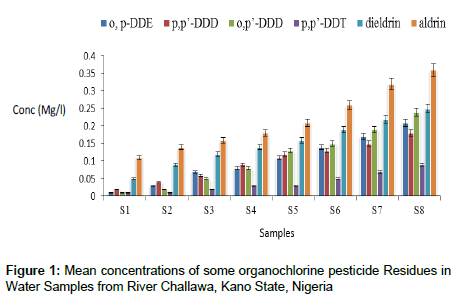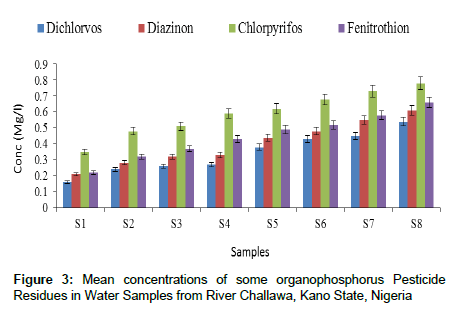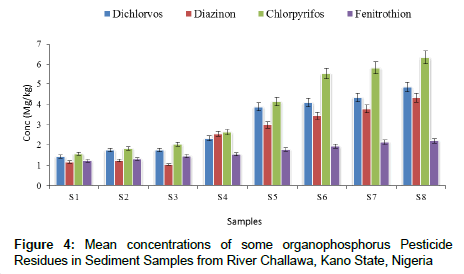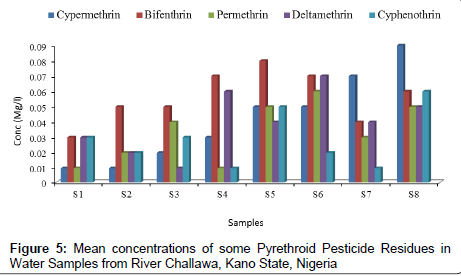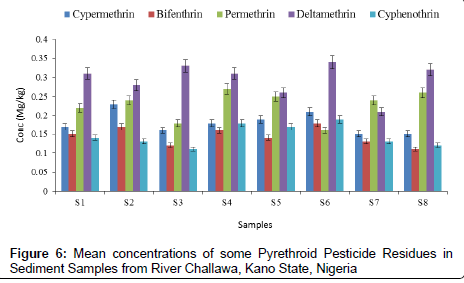Research Article Open Access
Determination of Organochlorine, Organophosphorus and Pyrethroid Pesticide Residues in Water and Sediment Samples by High Performance Liquid Chromatography (HPLC) with UV/visible Detector
Akan JC*, Sodipo OA, Mohammed Z and Abdulrahman FIDepartment of Chemistry, University of Maiduguri, P.M.B 1069, Maiduguri, Borno State, Nigeria
- *Corresponding Author:
- Dr. J.C. Akan
Department of Chemistry, University of Maiduguri
P.M.B 1069, Maiduguri, Borno State, Nigeria
Tel: +2348036000506
E-mail: joechemakan@yahoo.com
Received date: October 27, 2014; Accepted date: November 24, 2014; Published date: November 27, 2014
Citation: Akan JC, Sodipo OA, Mohammed Z, Abdulrahman FI (2014) Determination of Organochlorine, Organophosphorus and Pyrethroid Pesticide Residues in Water and Sediment Samples by High Performance Liquid Chromatography (HPLC) with UV/visible Detector. J Anal Bioanal Tech 5:226 doi: 10.4172/2155-9872.1000226
Copyright: © 2014 Akan JC, et al. This is an open-access article distributed under the terms of the Creative Commons Attribution License, which permits unrestricted use, distribution, and reproduction in any medium, provided the original author and source are credited.
Visit for more related articles at Journal of Analytical & Bioanalytical Techniques
Abstract
The concentrations of some organochlorine, organophosphorus and pyrethroid pesticide residues in water and sediment samples from river Challawa were investigated using High Performance liquid Chromatography (HPLC) with UV/visible Detector. The concentrations of organochlorine and organophosphorus pesticide residues were significantly higher in the sediment samples when compared to water samples. According to the concentrations and detection frequency dieldrin and aldrin were the most dominant compounds among the organochlorine pesticide residues, while chlorpyrifos and dichlovos; permethrin and deltamethrin were the dominant compound among the organophosphorus and pyrethroid pesticides respectively. The result also indicates that the water and sediment samples within the study area were contaminated by dichlovos, diazinon, chlorpyrifos, fenitrothion, dieldrin, aldrin, DDT, DDE and DDDs. The results also show that there is still exists a variety of the studied pesticide in the water and sediment from river Challawa. Despite bans and restrictions on the usage of some of these pesticides in Nigeria, the observed concentrations of the studied Organochlorine and organophosphorus and pyrethroid pesticidesin the eight sample points could explain either their persistence in the environment or continued use in the study area.
Keywords
Organochlorine; Organophosphorus; Pyrethroid; Pesticides; Water; Sediment; HPLC
Introduction
Surface water contamination with pesticide residues, associated with decreased water quality and increased exposure of human and wildlife has been detected in lakes, rivers and streams in various locations, especially in areas with intense and prolonged pesticides applications [1,2]. Pesticides can reach surface waters through various pathways, including agricultural run-offs, spray drifts during applications, atmospheric fallout, direct spills and accidental discharge. Irrigation waters, which are frequently taken from surface water sources in agricultural areas, may also transfer contaminants from land to the water body [1]. The types and concentrations of pesticides found in surface waters can be affected by a number of factors including properties of the chemical, application history, season of the year, and physicochemical characteristics of the water and the underlying sediments [3].
Water and sediments play an important role in the distribution of contaminants in aquatic environments. While pesticide molecules can dissolve in water, a large proportion binds to suspended particles and settles at the bottom of the water body, producing contaminated sediments [4]. Some pesticides, particularly those with hydrophobic nature and low water solubility can be retained on the organic phase of sediments through sorption, and thus found in higher concentrations than those detected in the overlying waters [1]. The analysis of pesticide residues in sediments and water has therefore proved to be an important approach in assessing the fate of these contaminants in aquatic environments and contamination history of an area. While the analysis of water samples gives important information on the water quality and the detection of any potential risks, sediment analysis enables the detection of pollutants that could not be quantified by the water analysis.
The analysis of environmental pollutant and their metabolite in different compartment of the environment have been widely used to study the risk posed by this kind of contaminant to aquatic systems. Organochlorine pesticides have been of global concern due to their chronic toxicity, persistence, tendency to accumulate in biota and potential negative impact on human and other wildlife [1]. They are persistent, broad spectrum toxicants that accumulate in the food web with high risks to the ecosystem and human health [5]. The used of Organochlorine pesticides has been banned for over a decades worldwide, including Nigeria. But many are still in use because of their low cost, versatility and availability.
Pyrethroids are organic contaminants with high hydrophobicity (log Kow ranging between 5.7 and 7.6) and very low water solubility (of a few μg/L) [6]. For these reasons this group of insecticides tends to rapidly bind to suspended particulate matter or sediments [7] and low concentration is generally present in water [8]. Applied to land or for domestic purposes as vector control, pyrethroids can enter the aquatic environment through different processes such as atmospheric deposition, river runoff and municipal treatment discharges. Once associated with sediments, benthic organism exposure of pyrethroids can be via sediment particles (by ingestion or contact) or from interstitial water. In fish, exposure to pyrethroids can be through gill absorption due to their lipophilicity or through food webs. Historically, concern has existed regarding aquatic organism exposure to pyrethroids, particularly arthropods and fish, because of the high degree of toxicity observed in standard laboratory studies [9]. Pyrethroid 96 h LC50 for fish is typically in the range of 400–2200 ng/L [10]. Moreover, a number of recent studies have also suggested the carcinogenic, neurotoxic immunosuppressive and reproductive potential toxicity of pyrethroids in mammals [11]. Pyrethroid insecticides disrupt the normal function of the peripheral nervous system. Pyrethroids react with voltage-gated sodium channels on nerves, prolonging the time during which the channels are open. This results in the altered of nerve function, which manifests either as a series of short bursts or a prolonged burst, and is caused by repetitive discharge of nerve signals or stimulus-dependent nerve depolarization.
Kano (Lat. 11 59 m 18.3s N, Long 08 32 m 05.8s E) 418 meters above sea level is located in Kano State; it occupies a central position in Northern Nigeria. It is one of the developed industrial cities in Nigeria. Tannery and textile are some of the dominating industries and this could be one of the reasons for her high population density [12]. River Challawa (Lat 11° 52 m 41s N, Long 08° 28 m 09s E) 515meters above sea level originates from the Challawa Gorge dam in Challawa village and stretches to river Kano that empties into Lake Chad. The river receives waste from tanneries and textile industries, urban water storm, and agricultural runoffs from farming communities along its course. River Challawa serves as fishing, farming and water supplies for the communities in the area. The domestic water supply for Challawa, Sharada, and Bompai industrial areas and the surrounding comes from River Challawa [13]. Most farmers within river Challawa area used synthetic chemical pesticides to control pests on plant. Pesticides are extensively used in agricultural production to check or control pests, diseases weeds and other plant pathogens in an effort to reduce or eliminate yield losses and preserve high product quality. Lack of knowledge of the use and the effects of these pesticides among small and large scale farmers has resulted in their misuse and consequently the waste generated flows into river Challawa and may contaminates the river with a variety of pesticides acting as point sources. Such contaminations might accumulate in aquatic organism which may affect humans and other species that depend on such aquatic organism as food. Hence, the significance of this study.
Materials and Methods
Sample collection point
Water and sediment samples from these areas were collected and designated S1 to S8. Samples were collected from the Challawa Gorge dam (S1); at the bridge (S2). Water and sediment samples were collected at immediate point of effluent discharge from Challawa industrial estate into it (S3); 2 Km after effluent discharge point into river Challawa (S4); Point S5 was 2 Km from S4; 6 Km after effluent discharge point into river Challawa (S6); and the new water work after effluent discharge point into river Challawa (S7) which is 7 Km. Point S8 was 2 Km after the new water work.
Collection of water and sediment samples
Water samples were collected in 900 ml amber glass bottle previously cleaned by washing in non-ionic detergent, rinsed with tap water and later soaked in 10% HNO3 for 24 hours and finally rinsed with deionised water prior to usage. During sampling, sample bottles were rinsed with sampled water three times and then filled to the brim at a depth of one meter below the water from each sampling points. The samples were labeled and transported to the laboratory, stored in the refrigerator at about 4°C prior to analysis. Sediments samples from river Challawa (points S1 to S8) were collected using a Shipek grab sampler by scooping the top layer sediment (1 to 5 cm). One kilogram (1 kg) of sediment samples were collected at each point, wrapped in a labelled aluminium foil, the labeled samples were stored in an icepacked cooler and transported to the laboratory and stored in a freezers at 4°C awaiting analysis.
Sample preparation
One litre of water samples was extracted using ultrasonic extraction. Soxlet extraction was done with 20 mL of hexane: dichloromethane (3:1) for 30 min. The extract was concentrated with the aid of rotator evaporator. Pre-elution was carried out with the HPLC methanol. The concentration solvent extract was then analyzed for pesticides. Sediment samples were homogenized and dried with anhydrous sodium sulphates. A sub- sample of the sediment (20 g) was weighed into a clean extraction bottle. The samples were extracted for pesticides by ultrasonic extraction using a mixture of dichloromethane and nhexane in a ratio 2:3, having been subjected to a vigorous shaking in a sonication bath for 5 h. The solvent was separated and concentrated with a rotator evaporator. Pre-elution was carried out with HPLC methanol. The concentration extract was then analyzed for the organochlorine, organophosphorus and Pyrethroid pesticides.
High Performance Liquid Chromatography (HPLC) analysis
The solvent of the mobile phase of the HPLC is methanol and water (1:1). This was prepared by measuring 250 ml of HPLC grade methanol into a 500 ml flask and made up with 250 mL of distilled water. The HPLC model CECIL 1010 was switched on. The wavelength of the system was determined by using UV visible equipment. Little quantity of the stock solution was diluted with methanol and its wavelength determined by scanning. The flow rate was set at 1 mL/min, afterwards, the purging of the system commenced by allowing the system to run for some time. Each sample residues was dissolved in 1 ml methanol. The extracted residues was then loaded and injected into the valve of the chromatography system. The resulting chromatograph for each sample was printed out. The various retentions time was noted and the concentrations were determined and recorded.
Results
Concentrations of organochlorine pesticide residues in water and sediment samples
The concentrations of organochlorine pesticide residues (o,p’- DDE, p, p’-DDD, o,p’-DDD, p,p’-DDT, dieldrin and aldrin) in water samples from different sample points of river Challawa are as presented in Figure 1. The concentration of o,p’-DDE from point S1 to S8 ranged from 0.01 to 0.21 Mg/l; 0.02 to 0.18 Mg/l p, p’-DDD; 0.01 to 0.24 Mg/l o,p’-DDD; 0.01 to 0.09 Mg/l p,p’-DDT; 0.05 to 0.25 Mg/l dieldrin and 0.11 to 0.36 Mg/l aldrin. For sediment samples, the concentration of o,p’-DDE ranged from 0.21 to 1.06 Mg/kg; ; 0.34 to 1.21 Mg/kg p, p’- DDD; 0.14 to 0.33 Mg/kg o,p’-DDD; 0.14 to 0.33 Mg/kg p,p’-DDT; 0.51 to 1.45 Mg/kg dieldrin and 0.71 to 1.78 Mg/kg aldrin Figure 2.
Concentrations of organophosphorus pesticide residues in water and sediment samples
The concentrations of organochlorine pesticide residues (diclorvos, diazinon, chlorpyrifos and fenitrothion) in water samples from river Challawa is as presented in Figure 3. The concentration of diclorvos ranged from 0.16 to 0.54 Mg/l; 0.21 to 0.61 Mg/kg diazinon; 0.35 to 0.78 Mg/kg chlorpyrifos and 0.22 to 0.66 Mg/kg fenitrothion. The levels of organophosphorus pesticides in sediment samples are as presented in Figure 4. The level of diclorvos ranged from 1.43 to 4.48 Mg/kg; 1.16 to 4.32 Mg/kg diazinon; 1.56 to 6.34 Mg/kg chlorpyrifos and 1.22 to 2.2 Mg/kg fenitrothion.
Concentrations of Pyrethroid pesticide residues in water and sediment samples
The concentrations of Pyrethroid pesticides (cypermethrin, bifenthrin, permethrin, deltamethrin and cyphenothrin) in water samples from river Challawa is as presented in Figure 5: the concentrations of cypermethrin for point S1 to S2 ranged from 0.01 to 0.09 Mg/l; 0.03 to 0.08 Mg/l bifenthrin; 0.01 to 0.06 Mg/l permethrin; 0.01 to 0.07 Mg/l deltamethrin and 0.03 to 0.05 Mg/l cyphenothrin. For sediment samples the concentration of cypermethrin for point S1 to S2 ranged from 0.17 to 0.19 Mg/kg; 0.11 to 0.18 Mg/kg bifenthrin; 0.18 to 0.26 Mg/kg permethrin; 0.21 to 0.34 Mg/kg deltamethrin and 0.11 to 0.19 Mg/kg cyphenothrin (Figure 6).
Discussion
p,p’-DDT, o,p’-DDD p,p’-DDD, o,p’-DDE, Dieldrin and Aldrin
The highest concentration of p,p’DDT and its metabolites in the present study were observed at point S8, while point S1 shows the lowest concentrations in both water and sediment samples. The concentrations of the degradation products that is DDDs and DDE in all the sample points both in water and sediments were more than the parent compound DDT, which indicates past usage of the DDT pesticide. DDT normally degrades under aerobic condition to DDE and under anaerobic condition to DDD, thus a higher DDE + DDD/ DDT ratio is an indication of past usage [14]. Although the use of DDT has being banned in the Nigeria in 2008, but still in used. DDT and its DDE and DDD metabolites persist in the environment and are known to bioaccumulate in aquatic organism. DDT, DDD, and DDE have all been classified by NAFDAC as probable human carcinogens. The concentration of p,p’DDT and its metabolites were higher in the sediment samples when compared with water samples. Because of the hydrophobic characteristic of Organochlorine pesticides, it is expected that any Organochlorine pesticides present in the study area preferable bind to the particle phase in aquatic system and then accumulated to the sediment through sedimentation process. They have an affinity for particulate matter and one of their main sinks is thought to be river and lake sediments [15]. The concentrations of DDT and its metabolites in the water samples from the eight sampling points were above the set EU maximum contamination limit (MRL) of 0.02 Mg/l DDE and 0.02 Mg/l DDDs and DDT, with exception of point S1 for DDE, o,p’ DDD and DDT which were lower than the set limits. Similarly, the concentrations of DDDs, DDE and DDT detected in the sediment samples were higher than the set EU maximum residue limit (MRL) of 0.3 Mg/kg DDD, 0.2 Mg/kg DDT and 0.4 Mg/kg DDE, with exception of point S1 to S3 for DDE and DDT which were lower than the set limits. Hence, the result indicates that the water and sediment samples within the study area are contaminated by DDT, DDE and DDDs.
The highest level of Dieldrin and Aldrin were recorded at point S8, while the lowest value was recorded at point S1. According to this study, aldrin and dieldrin was the most dominant compound among the organochlorine pesticides. A similar observation was reported by [1]. Other work also reported the highest level of aldrin and dieldrin in the aquatic environment [1], dieldrin is a chlorinated cyclodiene that was widely used in the Nigeria. The National Agency for Food and Drug Administration and Control (NAFDAC) has banned the sale and supply of 30 different agrochemical products in the country which include dieldrin and aldrin. Because the toxicity of this persistent pesticide posed an imminent danger to human health, NAFDAC banned the most major uses of dieldrin and aldrin in 2008, but the product is still in used because the low cost and affordability. Endrin and dieldrin were detected in measurable concentrations in both water and sediment samples from river Challawa. The relatively higher concentrations of the two compounds in the sediment samples may be attributed to the fact that both endrin and dieldrin are not very soluble in water and therefore more likely to adsorb in sediments [16]. The concentration of dieldrin was slightly significantly higher than that of aldrin in both water and sediment samples. This could be an indication that there is more dieldrin in the environment compared to aldrin. This trend is supported by the fact that aldrin photolysis to dieldrin in the environment. These results are in agreement with those of the United States Department of Health and Human services (USDHHS), 1993 who reported that aldrin is readily and rapidly converted into dieldrin in plant and animal tissues. This is so because dieldrin is extremely non-polar and therefore has a strong tendency to adsorb tightly to lipids such as animal fat and plant waxes. It is for this reason that dieldrin bioconcentrates and biomagnifies through the terrestrial and aquatic food webs. The concentrations of organochlorine pesticides residues in both water and sediment samples increase with increased from points S1 to S8. Such variation might be due to intense agricultural activities within point S4 to S8. Also point S7 and S8 were the closest to the discharged route from Sharada industrial area and also falls within intense agricultural area, and thus might be receiving relative more agricultural and industrial inputs than other points.
Dichlorvos, Diazinon, Chlorpyrifos and Fenitrothion
The highest values of organophosphrous pesticide residues in the water and sediment samples were detected at point S8; while point S1 shows the lowest values. Among the OPs determined, Chlorpyrifos shows the highest concentration followed by Fenitrothion, while diazinon shows the lowest value in the sediment and dichlorvos was lowest in water. These pesticides are widely used as agricultural insecticides and also have many uses in households for pest control. The concentrations of organophosphorus pesticides residues in both water and sediment samples increases with increased in sample points (S1 to S8). Such variation might be due to more agricultural activities within point S4 to S8. Also point S7 and S8were the closest to the discharged route from Sharada industrial area and also falls within intense agricultural area, and thus might be receiving relative more agricultural and industrial inputs than other points. The maximum residue limits (MRL) is the maximum amount of the pesticide residue which is found in food substances that will not cause any health effect or hazard [17]. The concentrations of organophosphrous pesticide residues (dichlovos, diazinon, chlorpyrifos and fenitrothion) detected in the water samples fell above the set maximum residue limits (MRLs) of 0.004 Mg/l dichlovos, 0.002 Mg/l for diazion, 0.01 Mg/l for Chlorpyrifos and 0.003 Mg/l for Fenitrothion. The results therefore suggest that the concentrations of dichlovos, diazinon, chlorpyrifos and fenitrothion residues in the water samples from river Challawa may pose health hazard to the aquatic organism.
Cypermethrin
The highest concentration of cypermethrin in water sample was observed at point S8, while point S1 showed the least value. For sediment samples, the highest concentration was observed at point S2, while point S3 shows the lowest concentration. The concentration of cypermethrin did not follows same pattern and OCPs and Ops, instead they were fluctuation in concentrations within the sample points. Chronic symptoms after exposure to cypermethrin include brain and locomotory disorders, polyneuropathy and immuno-suppression, and resemble the multiple chemical sensitivity syndromes [18]. Cypermethrin is genotoxic in mouse spleen and bone marrow cells where it induces the chromosomal aberration and sister chromatid exchange [19]. It induces systemic genotoxicity in mammals by causing DNA damage in vital organs like brain, liver, kidney, apart from that in the hematopoietic system [20]. It possesses mutagenic activity inducing dominant lethal mutations in male germ cells of mice [21]. It induces chromosomal aberrations and single stranded breaks in DNA in the cultured human lymphocytes.
The concentrations of cypermethrin detected in the water and sediment samples from all the sample points fell below the EU maximum residue limits (EU-MRLs) values of 100 Mg/l for water and 200 Mg/kg for sediment [22]. The results therefore suggest that the concentrations of cypermethrin residues in the water and sediment samples from river Challawa may not pose health hazard in terms of synthetic cypermethrin pollution.
Deltamethrin
The highest concentration of deltamethrin in water sample was observed at point S3, while point S6 showed the least value. For sediment samples, the highest concentration was observed at point S7, while point S6 shows the lowest concentration. When deltamethrin gets on the skin, it can cause skin sensations like tingling, itching, burning, or numbness at that spot. These sensations usually go away within 48 hours. Deltamethrin can be mildly irritating if it gets in the eye. If enough deltamethrin is breathed in, it can cause headaches and dizziness. Although not common, individuals who have ingested large amounts of deltamethrin have experienced nausea, vomiting, abdominal pain and muscle twitches. The concentrations of deltamethrin detected in the water and sediment samples from all the samples points fell below the EU maximum residue limits (EU-MRLs) values 50 Mg/l for water and 100 Mg/kg for sediment [22]. The results therefore suggest that the concentrations of deltamethrin residues in the water and sediment samples from river Challawa may not pose health hazard in terms of synthetic deltamethrin pollution.
Bifenthrin
The highest concentration of bifenthrin in water sample was observed at point S1, while point S5 showed the least value. For sediment samples, the highest concentration was observed at point S8, while point S6 shows the lowest concentration. Bifenthrin is hardly soluble in water, so nearly all bifenthrin will stay in the sediment, but it is very harmful for the aquatic life. Even in small concentrations, fish and other aquatic animals are affected by bifenthrin. The concentrations of bifenthrin detected in the water and sediment samples from all the samples points fell below the EU maximum residue limits (EU-MRLs) values 100 Mg/l for water and 200 Mg/kg for sediment [22]. The results therefore suggest that the concentrations of bifenthrin residues in the water and sediment samples from river Challawa may not pose health hazard in terms of synthetic bifenthrin pollution.
Permethrin
The highest concentration of permethrin in water sample was observed at point S4, while point S6 showed the least value. For sediment samples, the highest concentration was observed at point S6, while point S8 shows the lowest concentration. In mammals, permethrin has complex effects on the nervous system. As in insects, it causes repetitive nerve impulses. It also inhibits a variety of nervous system enzymes: ATPase, whose inhibition results in increased release of the neurotransmitter acetylcholine [23]. Permethrin inhibits respiration (the process by which cells use sugars as an energy source) in a manner similar to other neurotoxic drugs. It is therefore not surprising that permethrin causes a wide variety of neurotoxic symptoms. At relatively high doses, these neurotoxic symptoms of permethrin include tremors, incoordination, hyperactivity, paralysis, and an increase in body temperature. Permethrin affects both male and female systems. It binds to receptors for androgen, a male sex hormone, in skin cells from human males [23]. The concentrations of bifenthrin detected in the water and sediment samples from all the samples points fell below the EU maximum residue limits (EU-MRLs) values 100 Mg/l for water and 200 Mg/kg for sediment [22]. The results therefore suggest that the concentrations of permethrin residues in the water and sediment samples from river Challawa may not pose health hazard in terms of synthetic permethrin pollution.
Conclusion
The result also indicates that the water and sediment samples within the study area were contaminated by dichlovos, diazinon, chlorpyrifos, fenitrothion, dieldrin, aldrin, DDT, DDE and DDDs and their concentrations were higher than the set EU maximum residue limit (MRL). The concentrations of pyrethroid pesticides in the water samples were lower than the set EU maximum residue limit (MRL). The results also show that there is still existence of a variety of organochlorine and organophosphorus pesticides in the water and sediment from river Challawa. Despite bans and restrictions on the usage of these pesticides in Nigeria, the observed concentrations of the studied organochlorine pesticides in the eight sample points could explain either their persistence in the environment or continued use in the study area.
References
- Zhou R, Zhu L, Yang K, Chen Y (2006) Distribution of organochlorine pesticides in surface water and sediments from Qiantang River, East China. J Hazard Mater 137: 68-75.
- Gao J, Liu L, Liu X, Lu J, Zhou H, et al. (2008) Occurrence and distribution of organochlorine pesticides - lindane, p,p'-DDT, and heptachlor epoxide - in surface water of China. Environ Int 34: 1097-1103.
- Carabias-Martínez R, Rodríguez-Gonzalo E, Fernández-Laespada ME, Calvo-Seronero L, Sánchez-San Román FJ (2003) Evolution over time of the agricultural pollution of waters in an area of Salamanca and Zamora (Spain). Water Res 37: 928-938.
- Lalah JO, Yugi PO, Jumba IO, Wandiga SO (2003) Organochlorine pesticide residues in Tana and Sabaki rivers in Kenya. Bull Environ Contam Toxicol 71: 298-307.
- Sarkar SK, Bhattacharya BD, Bhattacharya A, Chatterjee M, Alam A, et al. (2008) Occurrence distribution and possible source of Organochlorine pesticide residues in tropical coastal environment in indian: An overview. Environ Int 34: 1062-1071.
- Laskowski DA (2002) Physical and chemical properties of pyrethroids. Rev Environ Contam Toxicol 174: 49-170.
- Solomon KR, Giddings JM, Maund SJ (2001) Probabilistic risk assessment of cotton pyrethroids in aquatic ecosystems: 1. Distributional analyses of laboratory aquatic toxicity data. Environ Toxicol Chem 20: 652-659.
- Feo ML, Eljarrat E, Manaca MN, Dobaño C, Barcelo D, et al. (2012) Pyrethroid use-malaria control and individual applications by households for other pests and home garden use. Environ Int 38: 67-72.
- Osti SC, Varoli F, Matushima E, Bernardi M (2007) Comparative studies of delthametrin acute toxicity in exotic and Brazilian fish. J Braz Soc Ecotoxicol 2: 101-106.
- Werner I, Moran K (2008) Effects of pyrethroid insecticides on aquatic organisms. In: Gan J, Spurlock F, Hendley P, Weston D, (ed) Synthetic pyrethroids: occurrence and behaviour in aquatic environments, Volume 991. ACS symposium series: American Chemical, Washington, DC.
- Jin Y, Liu J, Wang L, Chen R, Zhou C, et al. (2012) Permethrin exposure during puberty has the potential to enantioselectively induce reproductive toxicity in mice. Environ Int 42: 144-151.
- Olanrewaju DO (2001) Urban infrastructure: a critique of urban renewal process in Ijora Badia. Lagos. Habitat International 25: 373-384.
- Felsner G (2003) Technical Report: “Improving Tannery pollution control in Kano” Prepared for The Government of Nigeria by UNIDO. YA/NIR/03/440/11-52.
- Tadeo JL (2008) Analysis of pesticides in food and environmental samples. CRC Press, Taylor and Francis Group, LLC, Boca Raton, Fl.
- Kim KS, Lee SC, Kim KH, Shim WJ, Hong SH, et al. (2009) Survey on organochlorine pesticides, PCDD/Fs, dioxin-like PCBs and HCB in sediments from the Han river, Korea. Chemosphere 75: 580-587.
- Konstantinou IK, Hela DG, Albanis TA (2006) The status of pesticide pollution in surface waters (rivers and lakes) of Greece. Part I. Review on occurrence and levels. Environ Pollut 141: 555-570.
- Gerken A, Suglo JV, Braun M (2001) Crop protection policy in Ghana for Ministry of food and agriculture. Published by intergrated crop protection project PPRST/GTZ, Pokuase/Accra, 162.
- Müller-Mohnssen H (1999) Chronic sequelae and irreversible injuries following acute pyrethroid intoxication. Toxicol Lett 107: 161-176.
- Giri S, Giri A, Sharma GD, Prasad SB (2003) Induction of sister chromatid exchanges by cypermethrin and carbosulfan in bone marrow cells of mice in vivo. Mutagenesis 18: 53-58.
- Patel S, Pandey AK, Bajpayee M, Parmar D, Dhawan A (2006) Cypermethrin-induced DNA damage in organs and tissues of the mouse: evidence from the comet assay. Mutat Res 607: 176-183.
- Shukla Y, Yadav A, Arora A (2002) Carcinogenic and cocarcinogenic potential of cypermethrin on mouse skin. Cancer Lett 182: 33-41.
- Codex Alimentarius Commission (2009) Pesticide residues in food: Maximum Residue Limits. Extraneous Maximum Residue Limits.
- Vijverberg HP, van den Bercken J (1990) Neurotoxicological effects and the mode of action of pyrethroid insecticides. Crit Rev Toxicol 21: 105-126.
Relevant Topics
Recommended Journals
Article Tools
Article Usage
- Total views: 18429
- [From(publication date):
December-2014 - Apr 04, 2025] - Breakdown by view type
- HTML page views : 13063
- PDF downloads : 5366

